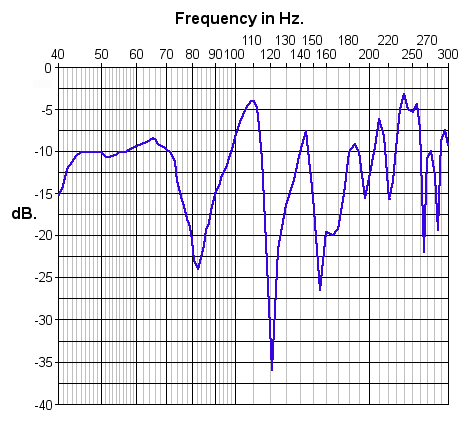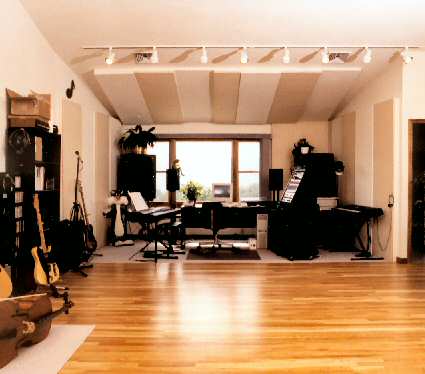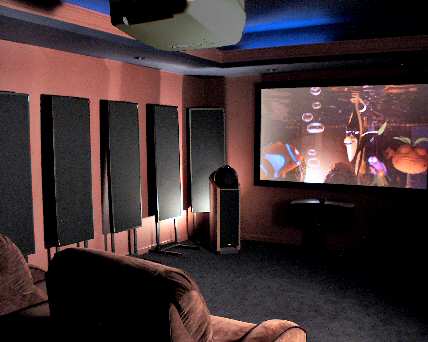Bass Traps - Not Just for Fisherman!
|
Moderator Username: AdminPost Number: 82 Registered: Dec-03 | If you ask most audiophiles to describe the main acoustic problem in their listening rooms, they'll probably tell you there's too much ambience and echoes. Or perhaps they'll report that stereo imaging is poor, most likely due to early reflections off the side walls and ceilings. Indeed, everyone "knows" that to test the acoustics of a room you simply walk around and clap your hands while listening for reverb and echoes. But to my way of thinking a far more important problem occurs at low frequencies, and you'll never hear that with hand claps. Let's first take a step back and consider the bigger picture. All room acoustic problems are caused by reflections off the walls, floor, and ceiling. In a large room like an auditorium or gymnasium, the large distances between walls - and between the floor and ceiling - create very long reverb times. So if you clap your hands in a large space, it can take many seconds for the sound to fade away completely. These rooms also have many reflective surfaces, so sound waves can bounce back and forth quite a few times before they fade away. However, small rooms like you find in a house have very different properties. In a normal living room or home theater the room boundaries are too close together to create true reverb. Rather, such rooms are dominated mainly by echoes at mid and high frequencies, and modal (dimension-related) resonances at low frequencies. Plus, the couches, bookshelves, and other furnishings tend to absorb and diffuse a lot of the reflected sound so it doesn't linger. Echoes in a small room often arrive too quickly to be perceived as distinct echoes, but they're still echoes more than they are reverb for a variety of technical reasons. More to the point, audible echoes and ambience are mainly an issue at mid and high frequencies. They are also easily tamed with thin materials like rigid fiberglass and acoustic foam panels. Even something as simple as carpet, throw rug, or heavy drapes can make a meaningful improvement in a room's acoustic properties at mid and high frequencies. How Low Can You Go? Much more difficult to control - and far less obvious to the untrained ear - are problems caused by reflections at low frequencies, which for these purposes I consider to be below about 300 Hz. Low frequency reflections are responsible for two main problems: One is modal ringing, which is a result of the room's natural resonances. For a given spacing between a pair of parallel walls there will be a series of low frequencies that tend to sound louder, and sustain longer, than other low frequencies. This ringing makes music sound boomy; thus, it is difficult to distinguish which notes are being played by bass instruments. You can hear that low frequencies are present, but you can't discern individual notes. This effect is sometimes referred to as "one-note" bass because all of the notes sound the same - muddy! Another even more important problem caused by low frequency reflections is the severely skewed low frequency response that exists in all small rooms. No matter how much you paid for your loudspeakers, and regardless of their published frequency response, as soon as you put them in a typical home-sized room they will exhibit a series of peaks and deep nulls that extends throughout the entire bass range. Figure 1 shows the response in a typical 16 x 10 x 7-1/2 foot room that has no acoustic treatment.  Figure 1: This terrible low frequency response is quite typical in small rooms. This horribly skewed low frequency response is the result of bass waves bouncing off the walls, floor, and ceiling, then combining with the direct sound waves still leaving the loudspeakers. At some frequencies and locations in the room, the reflections combine with the direct waves more or less in phase, which creates a peak in the response. At other frequencies and locations, the waves may be out of phase, and that creates a null. Peaks are usually less than 6 dB, but the nulls can be extremely deep, depending mainly on how rigid and thus reflective the room surfaces are. As you can see, nulls can easily be as deep as 30 dB or even deeper, especially in the middle and upper bass range above around 70 or 80 Hz. At very low frequencies sound waves tend to pass right through most walls, which is why you hear mainly thumping in an adjacent room. Standard sheet rock walls also tend to absorb very low frequencies as they vibrate in sympathy. But the higher bass frequencies are reflected instead of being passed and absorbed, and this is the cause of both modal ringing and a skewed low frequency response in the mid to high bass range. I consider nulls to be more damaging than peaks because they can totally obliterate bass notes. In Figure 1 the very large dip at 82 Hz corresponds exactly to an E note on a bass instrument. If an electric bass is playing that note, you will hear no fundamental tone at all - only the second harmonic an octave above. However, the second harmonic at 164 Hz is also in the middle of another deep null. To my way of thinking, the total and sudden absence of any bass note is a serious problem, and is far more significant than a few dB boost that merely adds a little fullness. Further, most rooms have a large dip somewhere between 80 and 120 Hz right at the listening position. Many people first notice this as a severe lack of bass that goes away when they walk away from the couch. Okay, So Now What? Now that we've identified the major acoustic problems at low frequencies, let's look at the best ways to solve them. One thing that can help a little is experimenting with different speaker placements. Since all low frequency problems are caused by reflections, changing the distance between the speakers and the walls (and floor) can affect the peak and null frequencies. Likewise, changing where you sit affects these frequencies too. You certainly won't be able to flatten the response completely by placement alone, but you may be able to shift the peak and null frequencies up or down to move them to a less objectionable range. However, this won't do much to reduce the muddiness caused by modal ringing, but it's at least worth trying as a first step. The ideal passive solution for low frequency problems in all small rooms is bass traps. These are mechanical devices that absorb bass, and there are several different types. I'll describe some of the common designs, and explain the pros and cons of each. But first allow me to debunk a common myth about bass traps. Often someone will ask for my advice about a lack of bass in their system. But when I suggest they need bass traps, I often hear, "I don't want to trap the bass because I already have too little. I need more bass!" In truth, adding bass traps to a room generally increases the perceived level of bass. Since the damaging nulls are caused by reflections from the room boundaries, a bass trap is designed to absorb sound rather than reflect it. And when the reflections are reduced, the low frequency response becomes flatter. At locations where certain bass frequencies were cancelled, adding bass traps increases the level. Of course, other places in the room experience peaks in the response, so in that case bass traps do reduce the level. But the real point is that bass traps tend to flatten the response, whether by increasing or decreasing the level at various frequencies. Types of Bass Trap There are three common types of bass traps, and a few variations within each type. One popular type is called a Helmholtz resonator, named for Herman von Helmholtz (1821-1894), a leading scientist of his era. The principle is very simple and is based on a large box with a small opening that resonates at a particular frequency. Think of a soda bottle that sounds a tone when you blow across its mouth, and you have the general idea. Any sound waves at the trap's resonant frequency cause the air inside to move back and forth. Since it takes energy to move the air, that energy is removed from the room. This is an oversimplification to be sure, but it's close enough for our purposes. Helmhotz resonators can be designed for narrow bandwidth (to remove one problem frequency), or broad band, to operate over a large range. However, they are necessarily rigid and heavy structures. They are not easy to build and take up considerable space usually.  Figure 2: These wood panel bass traps are in the author's home recording studio, and they're built directly onto the walls in the front of the room. Additional traps, not visible in this photo, are installed on the side and rear walls. Another, more popular type of resonant bass trap is the membrane absorber, often called a panel trap because it uses a front panel made of thin plywood or a similar material. Panel traps also use fiberglass to broaden their range of absorption, and when designed well they are effective over a range of about an octave. This is still not ideal, but it's broader range than a narrow band Helmholtz absorbers. When panel traps are used to treat a room, two different types are usually built - one having a center frequency of around 100 Hz and another centered at around 200 Hz. This yields an acceptable amount of absorption in the important bass range of 80 to 300 Hz. Although, not as cumbersome and difficult to build as Helmhotz resonators, they are still large and bulky, relatively expensive, and require a fair amount of labor to build. In my opinion, the best type of bass trap for most rooms is a broadband absorber based on rigid fiberglass. Rigid fiberglass is similar to the fluffy type used for home insulation, but it's compressed to about one quarter its original thickness and formed into panels one to four inches thick. A three-inch thick panel of rigid fiberglass is therefore about as absorbent as regular fiberglass one full foot thick. The overwhelming advantage of rigid fiberglass traps is they're not based on resonance so they operate over a much wider range of frequencies. Indeed, rigid fiberglass panels are commonly used to absorb mid and high frequencies too. Even higher performance can be achieved by combining rigid fiberglass with a membrane. Such a hybrid design can achieve very high absorption over a wide range of frequencies, often down to 80 Hz and even lower. It's difficult to get substantial absorption below about 80 Hz using a fiberglass-based trap. Fortunately, as explained earlier, most rooms don't need much absorption below 80 Hz because sheet rock walls pass and absorb those very low frequencies. So unless you have walls made of cement or block, or have two layers of sheet rock for increased isolation between rooms, fiberglass bass traps are an ideal choice. Further, a parametric equalizer can be used to minimize resonance or modal problems at the low frequencies. You should always try to minimize bass problems passively, with a combination of speaker and listener position and appropriate bass traps before using a parametric. However, there may be practical limitations in the room, whereby you can not put in as many bass traps as you would like, or you may not be able to move the speakers into their optimal position. In cases like these, parametric equalizers, are ideal.  Figure 3: This is an example of commercial bass traps that combine rigid fiberglass with a membrane for enhanced absorption at low frequencies. This particular design is effective down to about 50 Hz. Absorption panels meant to tame mid and high frequencies are generally fairly thin, and they can be placed flat on the walls and ceiling where they intrude very little. However, bass traps by definition need to be fairly large, or at least thick, and they are most effective when placed in or near the room corners. You can definitely have too much absorption at mid and high frequencies, which results in a room that sounds lifeless and sterile. But it's probably not possible to have too much absorption at low frequencies. As more bass traps are added, the low end continues to become tighter sounding, and the low frequency response gets flatter. Conclusion It amazes me when I see a listening room or home theater filled with the most expensive gear available, and speakers that cost $10,000 each or even more, yet there's not one bass trap or any other acoustic treatment in sight. There is no question that acoustic treatment, and especially bass traps, are more important to achieving truly high fidelity than pretty much anything else. It's a real ear-opener the first time you hear music reproduced with the same detail, fullness, and low end clarity the original engineers heard when they produced the recording. Indeed, it is truly awesome to be able to hear each individual note the bass plays, with all notes sounding equally full and powerful. By Ethan Winer Ethan Winer is a professional musician and audio engineer for over 30 years. He is now the president of RealTraps in New Milford, CT. RealTraps is a manufacturer of high performance acoustic treatment and bass traps. He has written for many audio engineering magazines and can be regularly found on the web, spending countless unselfish hours educating others on acoustics. |
|
Unregistered guest | Hello, Im saving to start up a small personal recording studio and im on a tight budget trying to get my self through college. I was wondering if you could build a good sounding bass trap made of wood or any other material. If I could I would greatly appreciate a visual diagram (if u want to take the time) and dimensions for a good bass trap.thanks a lot, your help would be greatly appreciated. -Charlie |
|
80Hz Unregistered guest | Nice one, you definately helped smooth out my acoustics assignment, giving me more time to do the other things that are important in life like drinking and having fun! Audio rocks (till you have to get a job!). |
|
Gold Member Username: NuckPost Number: 3574 Registered: Dec-04 | Very poignant and timely for my needs. Much appreciated! And simple enough to understand as well. |
Main Forums
Today's Posts- Home Audio Forum
- Home Video Forum
- Home Theater Forum
- Car Audio Forum
- Accessories Forum
- All Forum Topics